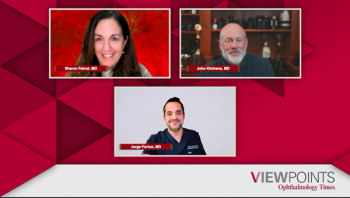
Finding your fit: Excimer lasers and early surgical practice
A young surgeon reflects on training, technology, and the human side of adopting new excimer laser platforms.
There are very few fields that evolve as rapidly (and as publicly) as refractive surgery. Nowadays, patients come to us expecting perfection—and rightfully so. The tools we have are better, safer, and more sophisticated than ever. For a new surgeon, this means not only mastering the fundamentals but doing so while navigating an ever-expanding landscape of technology, data, and digital workflows.
The jump from training to independent practice is a uniquely personal experience. For some, it feels like a natural next step. For others, it can be overwhelming. More often, it is a blend of confidence and uncertainty, excitement and pressure—all happening simultaneously.
I completed a 1-year private practice fellowship at Cleveland Eye Clinic/ClearChoice Custom LASIK in Cleveland, Ohio. This is a high-volume (and high-quality) practice that exposed me to a wide range of refractive procedures and multiple surgical platforms. Under the mentorship of Bill Wiley, MD and Shamik Bafna, MD, I was able to fit years of learning and surgical experience into a fast 12 months. One of the most important lessons from fellowship wasn’t how to master a particular technique or device. It was how to approach new technologies. You will not leave training knowing every tool you’ll use in your career, but if you’ve learned how to learn, you will be equipped to adapt.
For the first time in nearly 2 decades, we have multiple new excimer laser platforms introduced in the US market. This marks a significant milestone for surgeons and patients in the evolution of laser vision correction. With this influx of new technology, surgeons are faced with more options than ever. Which is the best? Regardless of where you are in your career, choosing to adopt a new excimer laser platform has real implications for workflow, practice economics, and most importantly, the care you deliver to patients.
Surgeon experience
Finding a platform that integrates seamlessly into your surgical environment is essential for success. What is your experience with excimer lasers? What about your technician’s experience? What type of footprint restrictions exist in your laser suite? Are there other required diagnostic devices? What range and type of treatments are you hoping to offer? These are all important considerations.
There are platforms that offer precise and fast wavefront-optimized treatments without the need for nomogram adjustments. This can accelerate the early adoption phase of a new laser and streamline your surgical practice. Nomogram refinement can be tedious, a source of error, and a potential barrier to entry for some surgeons. It requires time, effort, and occasionally growing pains. A no-nomogram excimer laser is ready to confidently treat straight “out of the box.” The majority of my excimer treatments are performed in this manor, and I continue to be impressed with the ease of use, the speed of treatment, and the visual outcomes.
Some platforms offer customized treatments, such as topography-guided or ray tracing–based ablations, designed to address corneal irregularities or higher-order aberrations across the entire optical system. For patients with irregular corneas or visually significant aberrations, these treatments can lead to improved visual quality and outcomes. However, for those with regular corneas, the added customization may offer limited benefit. It is important to note that these custom treatments typically involve more detailed imaging and preoperative planning.
Patient experience
As we navigate evolving platforms and surgical tools, it is easy to focus on the technology, but what matters most is how technology translates into patient experience and outcomes. A positive patient experience begins long before the procedure. A well-choreographed and streamlined workflow sets the stage, likely before they even meet the surgeon. It gives patients confidence that this is a road frequently traveled, and that they are being cared for by a group of knowledgeable experts. Also, let’s be honest—a streamlined workflow keeps patients engaged and moving forward, which is essential in an era where a 15-second TikTok often feels too long.
The diagnostics you acquire will be partially guided by what devices you own and what excimer laser you use. As I mentioned, the excimer laser that I routinely use does not require much in the ways of additional diagnostics. Treatments are performed by entering the manifest refraction, and a few other parameters such as optical zone, target refraction, keratometry, pachymetry, and flap thickness. This means that for 99% of my laser vision correction consultations, I only need to get an autorefraction, a corneal topography, and tomography.
There are other superficial but significant considerations that affect the patient experience. What does your laser look like? Is it attractive enough to display on nonsurgical days? A sleek, almost futuristic-appearing laser lets a patient know that their surgeon offers the latest technology. A large, aesthetically unappealing laser does not always inspire confidence and can look intimidating. What does the surgical bed feel like? A successful surgery for the patient and for the surgeon starts with patient comfort. Sedatives help with anxiolysis, but you want them to be physically comfortable as well. A pillow under the knees and a blanket is always a nice touch. What do they hear? Gentle music or relaxed conversation is certainly more soothing than uncomfortable silence and can distract from the brief audible excimer laser pulses. These are just a few points of a much larger and important conversation.
Ultimately, a great outcome is not just measured by uncorrected visual acuity, but also by how someone feels about their care from start to finish. Technology matters, but probably not as much as you. Be confident in your recommendations, spend time to provide education without overexplaining, create special touch points such as a postoperative phone call or text message. This is how you make their experience worldclass. When a patient feels special, heard, educated, and empowered, good outcomes tend to follow suit.
Final thoughts
From 1 young surgeon to another—whether you’re just starting out, in the thick of training, or already seasoned—my message is to remain adaptable and embrace new technology. Make sure it aligns with your goals, fits your workflow, and has the ability to provide your patients the best care. Although refractive surgery is a technical endeavor, it is also deeply human. The most advanced laser platform in the world cannot replace the value of trust, empathy, or thoughtful communication. Build your practice on those principles, and success will follow.
Michael DeCourcey, MD
E: [email protected]
DeCourcey is an ophthalmologist specializing in cataract, refractive, and anterior segment surgery at the Waring Vision Institute in Mount Pleasant, South Carolina. He has no relevant financial disclosures.
Newsletter
Don’t miss out—get Ophthalmology Times updates on the latest clinical advancements and expert interviews, straight to your inbox.














































.png)


